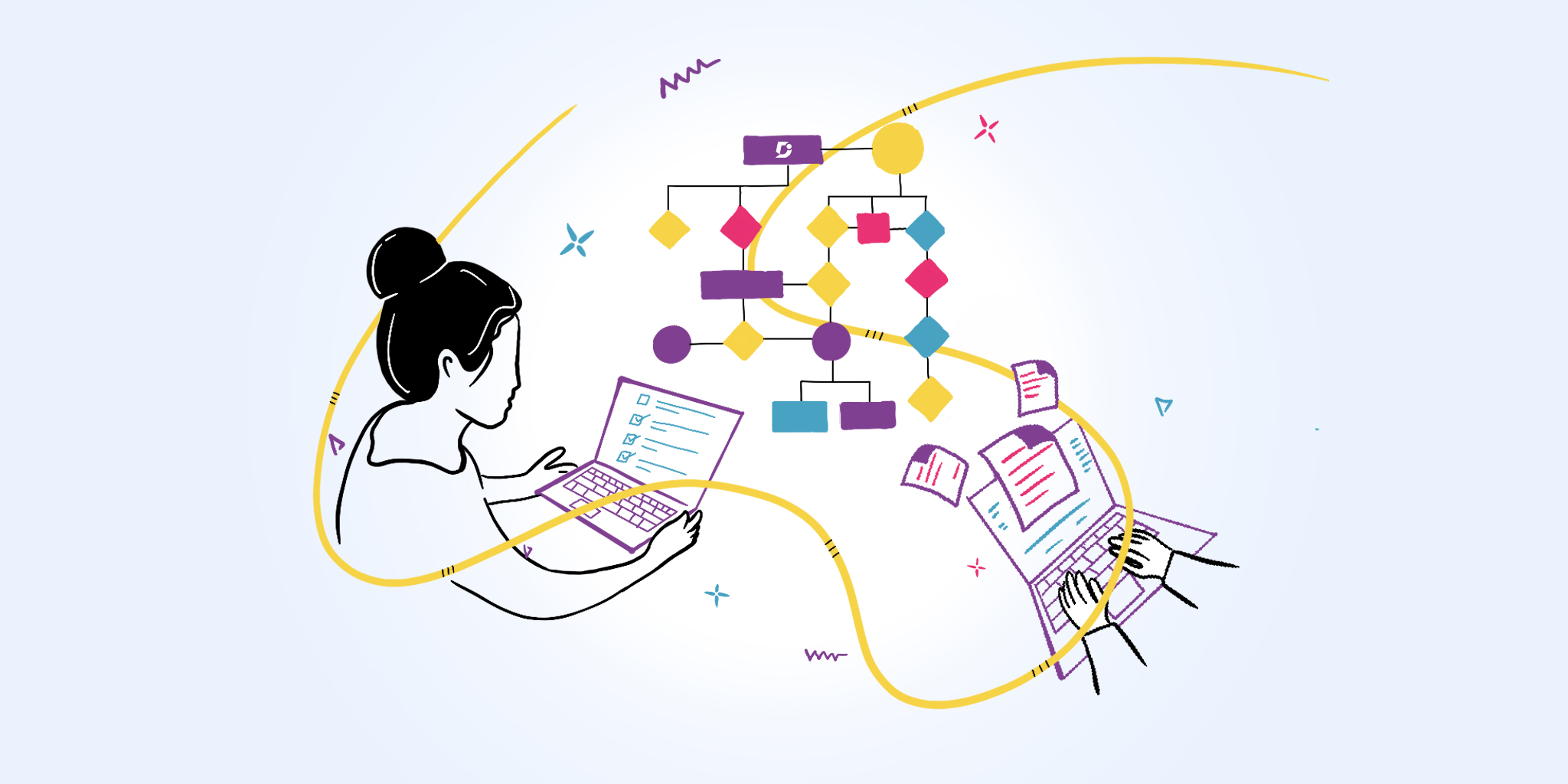Bank policy and procedures are the heart of any bank, fintech, or credit union company. It defines and clarifies administrative, compliance, lending, and operational procedures. These policies follow guidelines formulated by the Consumer Financial Protection Bureau (CFPB), Federal Deposit Insurance Corporation (FDIC), Federal Reserve, Office of the Comptroller of the Currency (OCC)
Does your bank have accurate, clear, and user-friendly policies and procedures? If not, you should learn how to create one today.
But before we get into that, let’s talk about “policies and procedures.”
- The policy is a set of guidelines – the “big picture” rules that clarify the culture of the bank.
- Procedures, on the other hand, are a series of step-by-step tasks to get things done.
Policy includes a Code of Risk Management, and Procedures involve opening an account and evaluating loan applications.
The term “bank policy and procedure” is the comprehensive or systematic approach to managing a bank’s operations, ensuring alignment with its business objectives, and promoting a culture of compliance, risk management, and customer-centricity.
Now, let’s learn how to write bank policies and procedures to ensure smooth operations, compliance with regulations, and customer satisfaction.
Importance of Developing Bank Policies and Procedures
There are several reasons why developing bank policies and procedures is worth it:
Unified approach among employees
According to McKinsey, organizations with a clear policy see a soaring 40% boost in teamwork and alignment.
When there is a clear policy and procedure in place, it eliminates confusion and departmental silos. With a clear policy and procedure in place, employees have a common understanding – and share the same goals and perspectives as the bank expects- that all have the same performance and behavior.
Under these regulations, all employees will do the same thing, and as a result, the risk of confusion will drop. A sense of organization, teamwork, and success will develop.
Mitigate the risk of non-compliance
Developing appropriate bank policies and procedures is a given for maintaining compliance. Policies and procedures serve to ensure that employees understand the importance of compliance and the consequences of non-compliance.
Quick One: Did you know that banks with formal risk management functions are less likely to receive enforcement actions from regulators?
The Federal Financial Institutions Examination Council (FFIEC) shows fewer enforcement actions for banks with policies than for the rest that don’t have policies.
Hence, if you have concerns about regulatory compliance, fraud prevention, or the bank’s reputation, you can be sure that the implementation of well-thought-out policies and procedures will solve them.
It is not just a matter of risk avoidance; it is about having a robust system that sustains the bank.
Building trust with regulators
Have you ever considered that the rules and guidelines set out by your bank may just earn you a few extra points with regulators? Yes, indeed.
Banks show seriousness about the law and keeping to proper boundaries through their policies and procedures.
Apart from the law, bank managers build trust when they act transparently. Knowing that it’s important to develop proper policies and procedures to strengthen the bank’s credibility and build trust with regulators.
Proactive approach to risk management
Ever think of how some banks hedge against risk more than others?
It’s all about taking action ahead of time! Let’s walk you through this.
Banking can use policies and procedures even to forecast possible risks that might occur in the future.
For instance, banks can take proactive security measures by implementing various security measures, ranging from alarm systems to CCTV surveillance and security guards. Program developers provide software updates and training to employees to secure and save their customers’ data.
Banks always have to be one step ahead; if not, they might lose not just money but also their customers’ data, which is worse than money.
Help with employee training and development
Bank policies and procedures help with employee training and development. With the right policy and procedure in place, everyone in the bank —from frontline staff to executives—will get the necessary skills and training initiatives to excel.
Good to know: The training initiatives may cover various topics, such as regulatory compliance, product knowledge, customer service skills, leadership development, and technical competencies.
By aligning training programs with organizational guidelines, banks cultivate a culture of continuous learning and performance improvement, ultimately contributing to their success in the industry.
Schedule a demo with one of our experts to take a deeper dive into Document360
Book A Demo
How to Write Policies and Procedures
Writing banking policies and procedures involves a ton of tasks, activities, and functions. And if they’re not standardized, things can get messy quickly. Or you might even find it challenging to write. Here are some top tips to help you in writing an exceptional policy/ procedure.
Gather information in the Central hub
The first step in writing bank policy and procedure is to get all the needed information. This can be established by creating a central store where all the required information can be stored and retrieved.
It’s good to know that the Document360 knowledge base portal has a drive feature that allows you to store and manage all your information—images, videos, files—so you can retrieve it easily.
The stored information must be presented simply and straightforwardly for people to see and understand clearly. Also, all of the parties involved in the information-gathering process should be included– departments that will be subjected to the policy and procedures, as well as external partners or vendors that the bank works with.
Evaluate the gap between existing policies and procedures
The next step is to take the information gathered in Step 1 and use it to analyze existing policies and procedures to see if they meet performance standards or statutory requirements.
By following this step, bank managers will be able to identify opportunities to rectify the flaws in the existing policies and ensure that all policies and procedures remain relevant and in line with the bank’s goals and regulatory demands.
Here’s how to evaluate the existing gap in policies and procedures.
-
-
- Check existing documents for inconsistencies or conflicting instructions, and update old data.
- Evaluate the performance of existing policies and processes in meeting their set targets.
- Get feedback from stakeholders.
- Look for places where current policies and procedures are not applicable, whether in terms of compliance with regulations, clarity, effectiveness, or efficiency.
- Depending on the severity and impact of the identified gaps, prioritize the areas needing improvement.
- Make a policy revision plan.
- Monitor and adjust the policies when necessary.
-
Define the roadmap for each policy
Now, after following steps 1 and 2, let’s say things are missing in the existing policy and procedure. This means the bank has to create a new one. Every time a bank enforces a new policy, it needs a roadmap to help it implement, develop, and maintain its objective.
The roadmap typically includes the following components:
Policy Background
Introduce the policy objectives, the reasons for them, and any related background information. Consider the evolution of similar policies over the bank’s lifetime.
Understanding previous policies can reveal the reasons behind current issues and thus help avoid the mistakes that have already been made. Working on this step also enables stakeholders to comprehend the basis of the policy and its significance to the bank.
Goal and Scope of the Policy
After working on the policy background, the next step is to define the goal and scope of the policies and procedures. This includes creating an agenda, identifying the target audience, and discussing how to align the duties.
Be sure to use the SMART method. The goals have to be specific, measurable, achievable, relevant, and time-bound. Also, examine the risks involved and how to monitor the effectiveness of the policies—this ensures that they are constantly effective and achieve the desired objectives.
Also Read: How to Simplify the Customer Onboarding in Banking?
Team for writing and reviewing the policy
The next step is team building. Identify the designated teams that are assigned to writing and revising policies.
Good to know: The policy writing teams should include subject matter experts, compliance officers, legal counsel, and relevant stakeholders.
Create a cross-functional team consisting of members from different departments with a view to a wide range of perspectives. Also, ensure clear role assignments for them to promote accountability and increase collaboration during policy development. This guarantees that the policies are balanced and efficient.
Communication Plan
Without good communication, nothing works.
All the stakeholders should understand their roles and responsibilities under the new policy. Achieve this through communication methods beyond training sessions and written materials – employ interactive workshops and gamification to catch attention.
Also, include feedback mechanisms in the implementation of the policy so that the stakeholders can provide input or raise concerns after the policy has been implemented.
Draft the structure of the documentation
After defining the policy roadmap, the next step is drafting.
Remember this, people skim before they read. If your documents are not well-structured, no one will read them.
Your documents should include sections, sub-sections, headings, and visual aids for a smooth flow and to enhance readability and comprehension.
Apart from readability, having structured documentation also helps:
-
-
- Streamlines audits, ratings, and supervisions.
- The bank demonstrates its integrity as it emphasizes compliance and risk management.
- Reins in and reassures regulators, investors, and customers.
- Guarantee sustainable success in a highly competitive banking industry
-
Choose the right platform
Choosing the right platform is one of the most important decisions a bank has to make. A slight mistake in this decision could make or mar the bank.
Here are some factors to consider to make the decision process easier:
-
-
- Security: Instead of using a regular document system, choose an online knowledge base system like Document360, which limits access to policies and procedures to only authorized employees while maintaining their confidentiality.
- Mobile friendliness. According to statistics by B2B reviews, about 32.6 million Americans are estimated to be working remotely by 2025. What does this mean for your bank? You need a platform to make it easier for your workers to access your policies through their mobile devices for more flexibility and accessibility.
- Simple to use interface. A platform with a user-friendly interface significantly reduces the learning curve and can be adopted by a bigger number of users in the organization. Employees should not have any problems with the platform operation and locate the necessary information quickly. It has to be available easily.
- Version control. The platform you choose needs to have a version control feature to prevent any deviations caused by obsolete documents and maintain uniformity in the process.
-
Recommended: Document360 is a self-service platform to build, share, and manage knowledge base, product documentation, manuals, SOPs, and more. It has a user-friendly interface and is bundled with powerful features like version control, Advanced WYSIWYG Editor, and feedback manager, and it integrates easily with all your third-party tools – chrome, slack, zapier, Google Analytics, etc.
Read our recent customer story:
UGA Finance needed an internal knowledge base to document their collection of internal policies and procedures for their staff of over 100 employees and another external knowledge base for user documentation which includes FAQs.
“Document360 was the perfect solution for us to create a database of annually reviewed policies and procedures. It helps us prove with evidence that we are doing daily, monthly, quarterly reviews.”- Jason Enneking, Chief Technology Officer / CISO, UGA finance
Follow the consistent layout
With clear headings, subheadings, and bullet points, you’d give your readers a smooth ride through the content, making it easy to find what they need without any detours.
You can also highlight important points by using bullets, bold text, or color-coding. The use of these features would make your document more user-friendly and efficient.
Make sure that communication is clear and not confusing
Wherever possible, use simple language instead of jargon or technical terms.
Be specific about your policies and procedures, even giving examples or scenarios where necessary, so that there are no doubts or miscommunications.
Pro Tip: Use visual aids like flow charts or diagrams to aid understanding.
Define every complex term and concept
As we stated above, always use simple language. Avoid industry jargon, technical terms, and abbreviations.
Every complex term and idea must be thoroughly described; this is important when designing bank policies and procedures.
For example, instead of using terms like ‘AML’ or ‘KYC,’ you can just say, ‘Anti-money laundering’ or ‘Know Your Customer’.
Also, instead of using industry terms like ‘liquidity ratio,’ you could explain it by saying, “A liquidity ratio of 20% means the bank holds $0.20 in liquid assets for every $1 in liabilities.”
Caveat: These definitions/illustrations should be continually reviewed and updated to remain accurate and relevant over time.
Recommend reference articles to read
Always provide more resources and reference articles in your policies.
These resources/articles should include regulation requirements, best industry standards, company training materials, etc. All these can be provided during training sessions, incorporated in policy documents, or shared through digital platforms.
Reach the C-level team for their approval and support
Gain support from top-level executives when implementing new policies and procedures.
But how can you win them over?
Present your draft for their feedback and work on it. And also allow them to have input in the final document so they can feel more involved in the process, so it becomes easier for them to back you up.
Ensure easy access to policies and procedures
Lastly, make sure that every employee can access the policies and procedures with ease.
If you create the policy with Document360, all you have to do is send the employees a link to the document, and voila, they have access. There is no need to jump through hoops to give people access.
Conclusion
To sum up, bank policies and procedures are so important to the growth of the bank—smooth operation, observance of regulations, and satisfaction of clients, the list goes on.
By using the steps we discussed in this article and working with the right platform like Document360, you can take your bank policy and procedure to the next level.
An intuitive knowledge base software to easily add your content and integrate it with any application. Give Document360 a try!
GET STARTED


Frequently Asked Questions
-
How do I make a bank policy?
When developing a bank policy, you should identify the appropriate rules to maintain fairness and safety. These rules should be clear and precise so all employees can easily comprehend them. The next step is to get the approval of your seniors before finalizing policies since they must conform to organizational goals and regulations.
-
How do you write a bank procedure?
When writing a bank procedure, divide the task into small steps for easier understanding. Explain each step using simple language, making it understandable by every employee.
-
What should be included in a bank policy?
A bank policy must embody rules concerning staff behavior, customer service standards, and financial transaction security protocols. It should also entail instructions on how to deal with diverse situations like fraud or emergencies.
-
Why do banks have policies and procedures?
Banks have policies and procedures to set expectations for employees, consequently ensuring uniformity and transparency among the personnel concerned. These guidelines prioritize maintaining order while keeping clients and workers safe from possible harm that might be caused by confusion associated with running their activities in the banking industry.






